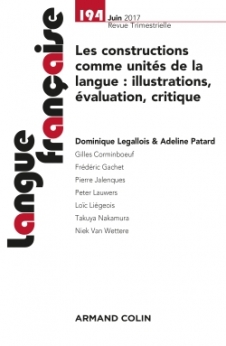
Langue française n° 194 (2/2017)
Pour acheter ce numéro, contactez-nous
Recevez les numéros de l'année en cours et accédez à l'intégralité des articles en ligne.
Nous examinons la possibilité d’extension de la classe de constructions copulatives dites spécificationnelles (et dans une moindre mesure, de constructions pseudo-clivées) à des structures transitives à verbe avoir, en tant que variantes contextuelles. Selon la réalisation du nom sous-spécifié (prépositionnel ou non), ce verbe présente deux variantes transitives de constructions spécificationnelles, dont le trait essentiel est de thématiser le support du nom sous-spécifié qui est inhérent à ce dernier par sa nature syncatégorématique.
We examine the possibility of extending the class of copular constructions called specificational sentences (and to a lesser extent, of pseudo-cleft constructions) to transitive structures with avoir, as contextual variants. According to the way in which the under-specified noun is realised (prepositional or not), this verb presents two transitive variants of specificational constructions, the essential trait of which is to topicalise the base of the under-specified noun, which is inherent to the latter because of its syncategorematic nature.